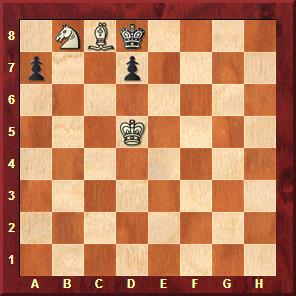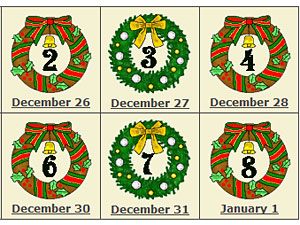ChessBase Chrismas Puzzles 2014 – solutions

December 29, 2014: My favourite studies
M. Klyatskin, Schachmat 1924

White to play and win

[Event "Schachmat"] [Site "?"] [Date "1924.??.??"] [White "Klyatskin,
M.G.."] [Black "White to play and win"] [Result "1-0"] [SetUp "1"] [FEN
"rR6/p7/KnPk4/P7/8/8/8/8 w - - 0 1"] [PlyCount "5"] [EventDate "1924.??.??"]
1. c7 $1 {This is indeed the solution.} (1. Rxa8 $2 Nxa8 2. Kxa7 (2. Kb7
Nc7 3. a6 (3. Kxa7 Kxc6 $10) 3... Nxa6 $10) 2... Kxc6 3. Kxa8 Kb5 $10)
(1. axb6 Rxb8 2. bxa7 (2. Kxa7 Kxc6) 2... Re8 3. Kb7 Re7+ (3... Ra8 4.
Kxa8 Kc7) 4. Kb8 Rxa7 5. Kxa7 Kxc6) 1... Kxc7 2. axb6+ $3 ({White does
not take the rook!} 2. Rxa8 $2 Nxa8 $11) 2... Kxb8 3. b7 $18 {[#]Another
memorable final position in this chess study.} 1-0
J. Gunst, Das illustrierte Blatt, 1922

White to play and win

[Event "Das illustrierte Blatt"] [Site "?"] [Date "1922.??.??"] [White
"Gunst, J."] [Black "White to play and win"] [Result "1-0"] [SetUp "1"]
[FEN "1NBk4/p2p4/8/3K4/8/8/8/8 w - - 0 1"] [PlyCount "9"] [EventDate "1922.??.??"]
{Amazingly} 1. Bb7 $3 {actually works, even though it drops a piece!}
(1. Ba6 $2 Kc7 2. Kc5 d6+ 3. Kd5 Kxb8 4. Kxd6 (4. Kc6 d5) 4... Ka8) (1.
Bxd7 $2 Kc7 $10 ) 1... Kc7 ({Black has no alternative:} 1... a5 2. Kd6
a4 3. Nxd7 a3 4. Bd5 { is a white win.}) 2. Ba6 Kxb8 ({Again no other
option:} 2... Kb6 3. Kd6) (2... d6 3. Nc6) {Now White has just the bishop,
but is able to deliver what is known as the "Troitzky mate" (after the
Russian study composer who first showed the idea).} 3. Kd6 Ka8 4. Kc7
d5 5. Bb7# {#} 1-0
December 30, 2014: My favourite studies (2)
Leonid Kubbel, Shakhmatny Listok 16.9.1922

White to play and win
In 1983 I wrote: "We do not know if your chess computer will find
the solution. At least two of them need less than ten minutes (!) to see
the knight sacrifice. We do not know exactly how they can do so..."
Today's chess engines do not waste a blink on any other move and find the
key move in 0:00 seconds.

[Event "Shakhmatny Listok"] [Site "?"] [Date "1922.??.??"] [White "Kubbel,
Leonid"] [Black "White to play and win"] [Result "1-0"] [SetUp "1"] [FEN
"1N6/8/K7/3k4/3p3B/p7/2PP4/8 w - - 0 1"] [PlyCount "11"] [EventDate "1922.??.??"]
1. Nc6 $3 (1. Bf6 a2 2. c3 (2. c4+ Kxc4 3. d3+ Kxd3) 2... a1=Q+ (2...
dxc3 $4 3. Bxc3)) (1. c4+ Kxc4) 1... Kxc6 2. Bf6 Kd5 {Now we have the
same position as in the diagram above, except that the knight is gone
(and the bishop is on f6). That is progress??} 3. d3 $1 (3. c4+ Kxc4 4.
d3+ Kxd3 $19) (3. c3 a2 $19) 3... a2 {The queening of the a-pawn still
cannot be prevented.} 4. c4+ Kc5 ({Taking the pawn en passant allows White
to recapture with the bishop and stop the pawn:} 4... dxc3 5. Bxc3 $18)
5. Kb7 $1 a1=Q 6. Be7# 1-0
A.V. and K.V. Sarychev, Shakhmatny Listok 1928

White to play and draw

[Event "Shakhmatny Listok"] [Site "?"] [Date "1928.??.??"] [Round "?"]
[White "Sarychev/Sarychev, A.V./K.V.."] [Black "White to play and draw"]
[Result "1/2-1/2"] [SetUp "1"] [FEN "8/1pPK3b/8/8/8/5k2/8/8 w - - 0 1"]
[PlyCount "9"] [EventDate "1928.??.??"] {Another truly amazing key move:}
1. Kc8 $3 (1. Kd6 $2 Bf5 2. Kc5 Ke4 3. Kb6 Bc8 $19) 1... b5 2. Kd7 $1
{White has forced the same position as the above, except that the black
pawn is on b5. That is progress? Well take a look at how it continues:}
b4 ({Or} 2... Bf5+ 3. Kd6 b4 4. Ke5 Bg4 5. Kd4 $11) 3. Kd6 Bf5 4. Ke5
Bg4 5. Kd4 $11 1/2-1/2
J. Moravec, La Strategie, 1913

White to play and win

[Event "La Strategie"] [Site "?"] [Date "1913.??.??"] [Round "?"] [White
"Moravec, J."] [Black "White to play and win"] [Result "1-0"] [Annotator
"Frederic Friedel"] [SetUp "1"] [FEN "7K/6p1/8/7p/8/8/R7/6k1 w - - 0 1"]
[PlyCount "9"] [EventDate "1913.??.??"] 1. Kh7 $1 (1. Kxg7 h4 2. Kg6 (2.
Ra3 Kg2 3. Kg6 h3 4. Ra2+ Kg1 5. Kg5 h2 6. Ra1+ Kg2 7. Ra2+ Kg1 $11) 2...
h3 3. Kg5 h2 4. Kg4 h1=Q 5. Kg3 Qh8 $1 $19 {and Black can guard the mating
square a1. That is why White could not take the g7 pawn on the first move.})
1... h4 (1... g5 2. Kg6 g4 3. Kg5 $1 {Now White doesn't take the *other*
black pawn!} g3 4. Kh4 g2 5. Kh3 Kh1 6. Rxg2 $18 {If he had the position
would now be stalemate.}) 2. Kg6 h3 3. Kg5 h2 4. Kg4 h1=Q 5. Kg3 $18 1-0
December 31, 2014: Curious chess
Dr. Karl Fabel, Rätselstunde, June 1952

White to play and not deliver mate
Solution: 1. Rc6+ is the only move that does not deliver
mate, because of 1...Rxh7
T. P. Madeley, Chess, December 1950

Mate in one move
Solution: Did you see it? 1.f4 mate is
not so easy to spot.
Pollmächer et.al. Illustrierte Zeitung, 1859

Mate in one move – how many solutions?
Solution: White has 47 moves that deliver
mate – count them if you don't believe it.
Dr Karl Fabel, Deutsche Schachblätter, 1950

Insert the black king so White can mate in one
There is only one place on the board for the black king where White can
mate in one. It cannot be on c1 because then the white king must have moved
to let it in, and so castling is illegal and there is no mate in one. Solution:
the black king must be placed on f3 and the mating move
is 1.0-0.
Author unknown

White to play and win
This is the easiest chess study ever composed: 1.d4 b5 2.d5 b4
3.axb4 a3 4.b5 a2 5.b6 a1=Q 6. b7 mate. Every move by both sides
(except the irrelevant black promotion) is the only legal move in the position.
T. R. Dawson

White to play
Read it carefully: White said "I'll bet you $100 that I can lose this
game!" The two made the bet and White lost. The solution is that he
did not lose the game, which is impossible from the above position –
he lost (ducking and running for cover) the bet!
| Thomas Rayner Dawson (1889– 1951) was a British
chess problemist, acknowledged as "the father of Fairy Chess"
(he invented many fairy pieces and new conditions). He composed less
for fame than to amuse himself, confessing to a colleague "We do
these things for ourselves alone." Dawson was, together with Karl
Fabel, one of the most humorous chess composers we know. |
|
Dr Karl Fabel, Deutsche Schachblätter, 1950

White to play and win – how many moves?

[Event "Deutsche Schachblätter"] [Site "?"] [Date "1950.02.??"] [Round
"?"] [White "Fabel, Karl"] [Black "White to play and win"] [Result "1-0"]
[Annotator "Friedel,Frederic"] [SetUp "1"] [FEN "8/2p5/8/8/1p1p1p2/1P1P1P2/8/2kBK3
w - - 0 1"] [PlyCount "91"] [EventDate "2002.12.25"] {You are not going
to believe this, but it actually takes 46 moves to force mate.} 1. Ke2
Kb2 2. Kd2 Kb1 3. Bc2+ Kb2 4. Kd1 Ka1 $1 5. Kc1 Ka2 6. Bd1 Ka1 7. Kc2
Ka2 8. Be2 Ka1 9. Bf1 Ka2 10. Bh3 Ka1 11. Bg2 Ka2 12. Bf1 {to lose a tempo}
Ka1 13. Be2 Ka2 14. Bd1 Ka1 15. Kc1 Ka2 16. Bc2 c6 $1 (16... Ka1 $2 17.
Bb1) ( 16... Ka3 $2 17. Kb1 {both lead to faster mates.}) 17. Bd1 Ka1
18. Kc2 Ka2 19. Be2 Ka1 20. Bf1 Ka2 21. Bh3 Ka1 22. Bg2 Ka2 23. Bf1 Ka1
24. Be2 Ka2 25. Bd1 Ka1 26. Kc1 Ka2 27. Bc2 c5 28. Bd1 Ka1 29. Kc2 Ka2
30. Be2 Ka1 31. Bf1 Ka2 32. Bh3 Ka1 33. Bg2 Ka2 34. Bf1 Ka1 35. Be2 Ka2
36. Bd1 Ka1 37. Kc1 Ka2 38. Bc2 c4 39. dxc4 d3 40. c5 d2+ 41. Kxd2 Kb2
42. c6 Ka3 43. Kc1 Ka2 44. c7 Ka3 45. c8=Q Ka2 46. Qa8# 1-0
Well, now you have the rest of this Sunday to submit your solutions
to our New
Year 2015 Puzzle Contest.














































